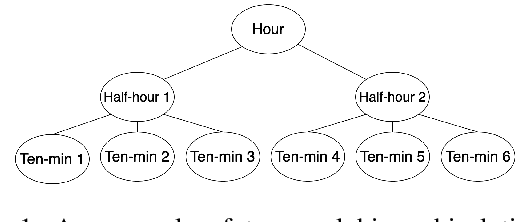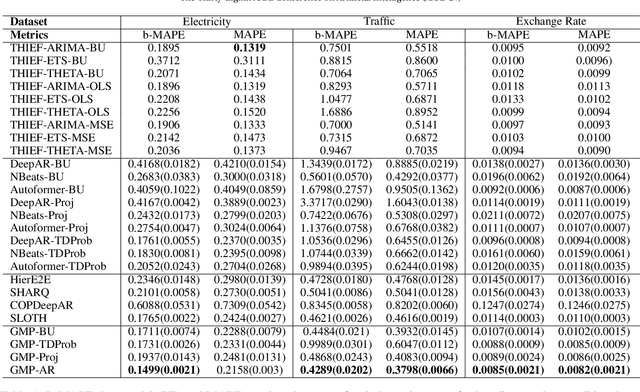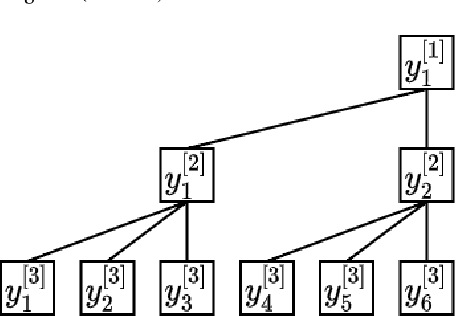Yunhua Hu
GMP-AR: Granularity Message Passing and Adaptive Reconciliation for Temporal Hierarchy Forecasting
Jun 18, 2024



Abstract:Time series forecasts of different temporal granularity are widely used in real-world applications, e.g., sales prediction in days and weeks for making different inventory plans. However, these tasks are usually solved separately without ensuring coherence, which is crucial for aligning downstream decisions. Previous works mainly focus on ensuring coherence with some straightforward methods, e.g., aggregation from the forecasts of fine granularity to the coarse ones, and allocation from the coarse granularity to the fine ones. These methods merely take the temporal hierarchical structure to maintain coherence without improving the forecasting accuracy. In this paper, we propose a novel granularity message-passing mechanism (GMP) that leverages temporal hierarchy information to improve forecasting performance and also utilizes an adaptive reconciliation (AR) strategy to maintain coherence without performance loss. Furthermore, we introduce an optimization module to achieve task-based targets while adhering to more real-world constraints. Experiments on real-world datasets demonstrate that our framework (GMP-AR) achieves superior performances on temporal hierarchical forecasting tasks compared to state-of-the-art methods. In addition, our framework has been successfully applied to a real-world task of payment traffic management in Alipay by integrating with the task-based optimization module.
Deep Optimal Timing Strategies for Time Series
Oct 09, 2023Abstract:Deciding the best future execution time is a critical task in many business activities while evolving time series forecasting, and optimal timing strategy provides such a solution, which is driven by observed data. This solution has plenty of valuable applications to reduce the operation costs. In this paper, we propose a mechanism that combines a probabilistic time series forecasting task and an optimal timing decision task as a first systematic attempt to tackle these practical problems with both solid theoretical foundation and real-world flexibility. Specifically, it generates the future paths of the underlying time series via probabilistic forecasting algorithms, which does not need a sophisticated mathematical dynamic model relying on strong prior knowledge as most other common practices. In order to find the optimal execution time, we formulate the decision task as an optimal stopping problem, and employ a recurrent neural network structure (RNN) to approximate the optimal times. Github repository: \url{github.com/ChenPopper/optimal_timing_TSF}.
Automatic Deduction Path Learning via Reinforcement Learning with Environmental Correction
Jun 16, 2023Abstract:Automatic bill payment is an important part of business operations in fintech companies. The practice of deduction was mainly based on the total amount or heuristic search by dividing the bill into smaller parts to deduct as much as possible. This article proposes an end-to-end approach of automatically learning the optimal deduction paths (deduction amount in order), which reduces the cost of manual path design and maximizes the amount of successful deduction. Specifically, in view of the large search space of the paths and the extreme sparsity of historical successful deduction records, we propose a deep hierarchical reinforcement learning approach which abstracts the action into a two-level hierarchical space: an upper agent that determines the number of steps of deductions each day and a lower agent that decides the amount of deduction at each step. In such a way, the action space is structured via prior knowledge and the exploration space is reduced. Moreover, the inherited information incompleteness of the business makes the environment just partially observable. To be precise, the deducted amounts indicate merely the lower bounds of the available account balance. To this end, we formulate the problem as a partially observable Markov decision problem (POMDP) and employ an environment correction algorithm based on the characteristics of the business. In the world's largest electronic payment business, we have verified the effectiveness of this scheme offline and deployed it online to serve millions of users.
SLOTH: Structured Learning and Task-based Optimization for Time Series Forecasting on Hierarchies
Feb 27, 2023



Abstract:Multivariate time series forecasting with hierarchical structure is widely used in real-world applications, e.g., sales predictions for the geographical hierarchy formed by cities, states, and countries. The hierarchical time series (HTS) forecasting includes two sub-tasks, i.e., forecasting and reconciliation. In the previous works, hierarchical information is only integrated in the reconciliation step to maintain coherency, but not in forecasting step for accuracy improvement. In this paper, we propose two novel tree-based feature integration mechanisms, i.e., top-down convolution and bottom-up attention to leverage the information of the hierarchical structure to improve the forecasting performance. Moreover, unlike most previous reconciliation methods which either rely on strong assumptions or focus on coherent constraints only,we utilize deep neural optimization networks, which not only achieve coherency without any assumptions, but also allow more flexible and realistic constraints to achieve task-based targets, e.g., lower under-estimation penalty and meaningful decision-making loss to facilitate the subsequent downstream tasks. Experiments on real-world datasets demonstrate that our tree-based feature integration mechanism achieves superior performances on hierarchical forecasting tasks compared to the state-of-the-art methods, and our neural optimization networks can be applied to real-world tasks effectively without any additional effort under coherence and task-based constraints
 Add to Chrome
Add to Chrome Add to Firefox
Add to Firefox Add to Edge
Add to Edge